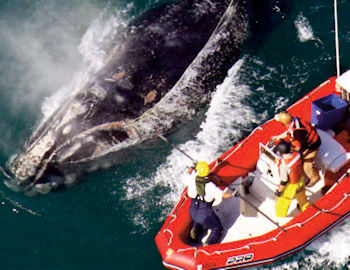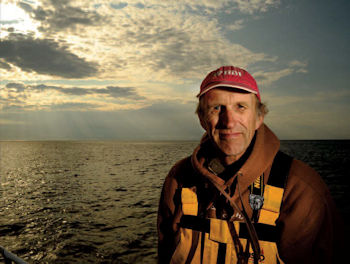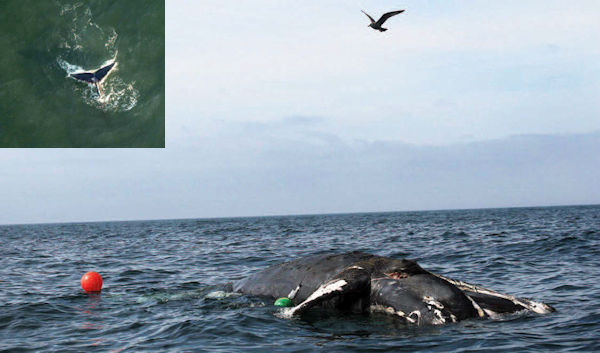SEJournal Online is the digital news magazine of the Society of Environmental Journalists. Learn more about SEJournal Online, including submission, subscription and advertising information.
Inside Story
 |
|
During an aerial survey on Christmas Day in 2010, wildlife officials spotted the year-old Bayla entangled tightly in fishing lines. After sedation, biologists seeking to free Bayla from the fishing gear wrapped around her were able to approach her safely and cut away the fishing lines which entrapped her. Photo: NOAA |
As a feature writer for The Boston Globe, Sarah Schweitzer often writes long form, intimate stories about the people who make news. But in 2014, a different kind of mammal figured prominently in her work. She spent part of last year writing “Chasing Bayla,” about one of the most endangered whales in the world — the North Atlantic right whale — and one scientist’s effort to save it. The end result was a Pulitzer Prize finalist in feature writing, winning praise for “a beautiful story fortified by expansive reporting, a quiet lyricism and disciplined use of multimedia.” (View it online here.) Schweitzer joined the Globe in 2001 and has covered politics and education. She previously reported for the St. Petersburg Times in Florida and the Concord Monitor in New Hampshire. She grew up in Texas and now lives in Etna, N.H. with her husband and two kids.
For the full photo layout of our story, download the Summer/Fall SEJournal.
SEJournal: How did the idea of doing a story on scientist Michael Moore and Bayla the whale come about?
Sarah Schweitzer: My editor and I were talking about story ideas and he said he’d love to read a story about whales. He was more musing than directive, but the notion appealed to me and I called Woods Hole Oceanographic Institution on a lark. The public relations person said she had just the person for me to talk with. In our first conversation, Michael Moore said, “I’ve failed.” In that moment, I knew I had to write his story. He was among the most revered scientists in his field. And yet, he felt the sting of failure. How could that be? Along the way, I fell in love with Bayla.
 |
|
Marine biologist Dr. Michael Moore on his 60' sailboat Rosita observing North Atlantic right whales in the Bay of Fundy near Grand Manan Island in August, 2014. Photo by Essdras M. Suarez, The Boston Globe |
SEJournal: The story is notable for keeping on narrative and not getting too deep into, for example, regulation of right whales. Was that challenging to do and, if so, how did you balance narrative and explanation?
Schweitzer: I began the story with a focus on narrative — of telling the arc of how Moore came to his love of whales and his quest to save them. Having this tight narrative focus made it easier to keep the spotlight on Moore and not get deep in policy, which can be a tough sell in a narrative story. In this way, regulations became the background and necessary only so far as they propelled Moore and his choices.
SEJournal: What did it take to make the piece so interactive, from hearing whale sounds to having an entire visual story parallel to the written one?
Schweitzer: In my early reporting, I discovered gripping video of Bayla’s rescue and a lot of photographs of Bayla from the start of her life to her end. It was clear, even to me, that there was visual potential. Multimedia people were interested and we bounced around ideas. When I produced the written story, they conceptualized the parallel visual story.
SEJournal: Do you think the fact that you do not cover environment as a beat helped you? Hindered you? How?
 |
|
Boston Globe reporter Sarah Schweitzer |
Schweitzer: I think it helped in the sense that I approached the story from a narrative angle, which allowed the story to breathe and not get bogged down in policy. That said, regulations were an important backdrop and it took me time to understand them — a step beat writers could have tackled more easily.
SEJournal: How long did the story take to report and write, and what challenges did you have?
Schweitzer: The story took six months from start to finish, with interruptions for other stories. I spent the bulk of the time reporting — visiting with Moore and other whale scientists, gathering history on Bayla, acquiring video of her rescue from NOAA. There were all the usual hurdles, most of all, getting normally private people to share their lives with the public — a leap of faith if ever there was.
SEJournal: What advice would you give to reporters eager to take on a narrative environmental project but who may not have dedicated time to do so?
Schweitzer: It’s great to get dedicated time, but if you can’t, allow the story to take over your mind. Talk about your characters with family and friends (to the point of harassment if necessary; ask my husband). Consider your characters’ motives while you’re exercising; imagine their childhoods when you’re falling asleep. The act of thinking about your characters keeps the story alive and hopefully prompts questions to ask of sources and spurs ideas for how best to tell the story. In this way, when you are freed up and have time to plunge back in, you’re ready to go.
“Inside Story” editor Beth Daley is reporter and director of partnerships at the New England Center for Investigative Reporting, a nonprofit newsroom based at Boston University and affiliated with WGBH News.
 |
|
Inset: Once freed of the entangling fishing gear, a temporary geo-tag tracked Bayla as she wandered up and down the southern coast for the next six days, after which her whereabouts were unknown. Main: A month later, a lifeless young right whale was reported floating in Florida waters. It was Bayla. Photos: NOAA |
* From the quarterly newsletter SEJournal, Summer/Fall 2015. Each new issue of SEJournal is available to members and subscribers only; find subscription information here or learn how to join SEJ. Past issues are archived for the public here.












 Advertisement
Advertisement 



